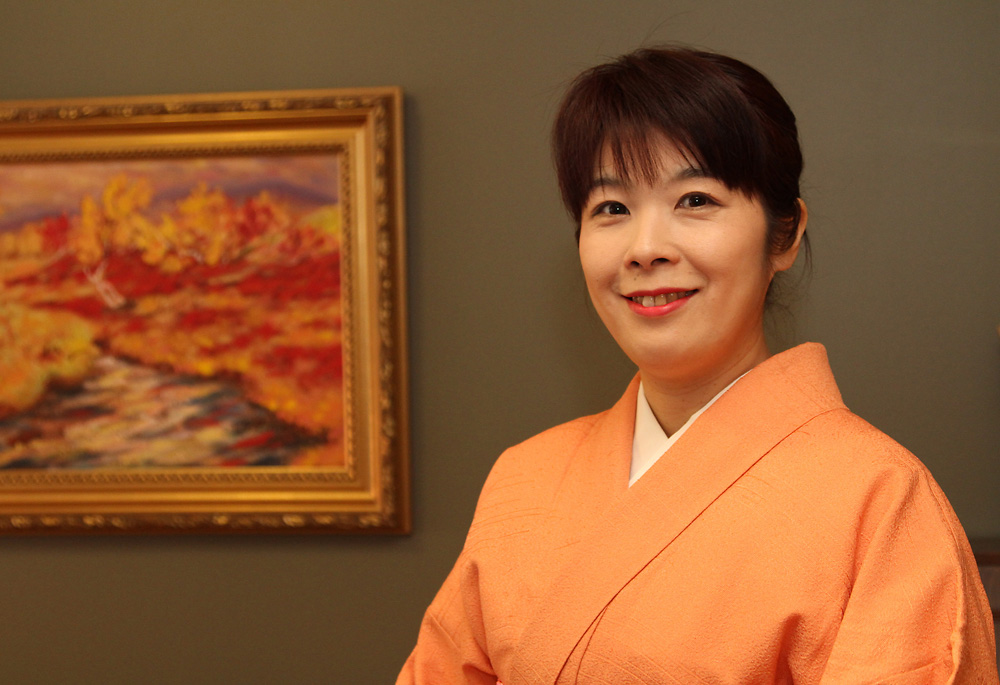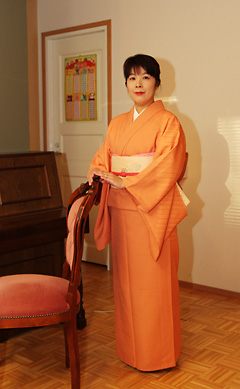
Soko Deguchi-Roininen has several kimonos for different times of the year, both for everyday and for festive occasions. She chooses brighter colours in the spring and summer than in the autumn and winter. Photos Päivi Arvonen
By Päivi Arvonen
Soko Deguchi-Roininen of Japan feels at home in Paloheinä, Helsinki. She appreciates the safety and the international side of her home city.
Kyoto-born Soko Deguchi worked as an English teacher in Japan 15 years ago, when she met her husband Petri Roininen. He was visiting Japan for business. At that time, she did not know anything about Finland apart from Santa Claus (Father Christmas) and the Moomintrolls.
“Staying in Japan wasn’t a realistic alternative,” she explains, “because it would’ve been difficult for my husband to find work there, so I moved to Finland.”
Her first impression of Finland was infused by darkness and silence. Compared with Kyoto, a city of 1.5 million people, Helsinki was peaceful and quiet.
“However, I’ve learned to know that the Finns are not quiet, contrary to the common belief. They are also very helpful and friendly.”
Help from the mother-in-law
After 14 years in Finland, Soko Deguchi-Roininen prefers to communicate in English. She has studied Finnish at the University of Helsinki Language Centre and at the Institute of Adult Education in Helsinki. But one of her best teachers has been her mother-in-law.
“In addition to my husband, my mother-in-law has helped me a great deal to feel at home in Finland. She and I speak Finnish together, but my father-in-law also speaks English.”
Deguchi-Roininen has had a great deal to learn in her new home country.
“For example, the Finnish educational and day care systems are completely different from the Japanese systems. At first I was also lost in the grocery store, when all information was only in Finnish and Swedish, and you would hardly get service in English anywhere, except for Stockmann at the most.”
Japan and everyday life

Deguchi-Roininen is happy in Helsinki, surrounded by tranquil nature in Paloheinä. Home sickness is eased by an annual visit to Japan. Deguchi-Roininen has also been active in the Finnish-Japanese circles. The family’s children ages 10 and 12 have been brought up as both Finns and Japanese.
The Japanese language and culture are strongly present in Deguchi-Roininen’s everyday life. She has taught at the Japanese school in Helsinki. Today she gives private lessons in Japanese. In addition to her language teaching, she teaches Japanese women in Finland about the kimono, the traditional garment of Japan.
“The kimono is part of me, and it’s comfortable to wear,” Deguchi-Roininen says, dressing up in a kimono in a quarter of an hour.
The kimono is a tradition that many Japanese no longer know. Deguchi-Roininen has been recommended that she should start a kimono school in Helsinki.
The first sights of Helsinki that Deguchi-Roininen would show to Japanese tourists include the Temppeliaukio Church (also known as Rock Church), Uspenski Cathedral and Esplanade Park. She is also fond of the Linnanmäki Amusement Park and recommends the Kaivopuisto Park in the summer with its opportunities for picnicking and cafés with magnificent views of the sea.
“I would like to see greater respect for history in Helsinki. Helsinki’s fabulous historical atmosphere is being overshadowed by contemporary design.”
Translated by Johanna Lemola
Friendship societies:
- Japania ry (“Japanese society”) was founded in 2002. This friendship society has more than 1,000 members, a few dozen of them Japanese. www.japania.org
- The Finnish-Japanese Society was founded in 1935. It has 1,100 members, less than 10 of them Japanese. www.suomi-japani.net
- The Friends of Japanese Culture Society www.japaninkulttuuri.net
- Society for teachers of Japanese language and culture www.nihongo.fi
- Society for Japanese people in Finland http://finnihonjinkai.jimdo.com/
The number of Japanese residents in Finland registered by the Japanese Embassy is 1,572. A total of 590 of them live in Helsinki.


